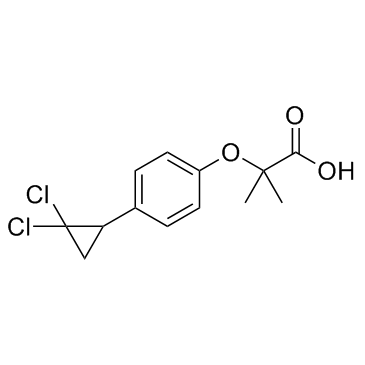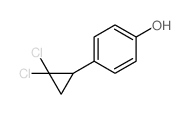Ciprofibrate

Ciprofibrate structure
|
Common Name | Ciprofibrate | ||
|---|---|---|---|---|
| CAS Number | 52214-84-3 | Molecular Weight | 289.155 | |
| Density | 1.4±0.1 g/cm3 | Boiling Point | 424.9±45.0 °C at 760 mmHg | |
| Molecular Formula | C13H14Cl2O3 | Melting Point | 114 - 118ºC | |
| MSDS | Chinese USA | Flash Point | 210.7±28.7 °C | |
| Symbol |

GHS08 |
Signal Word | Danger | |
Use of CiprofibrateCiprofibrate is a peroxisome proliferator-activated receptor agonist.Target: PPARCiprofibrate is a hypolipidemic compound that can induce proliferation of peroxisomes in liver cells of rats. Known to be a PPARα (peroxisome proliferator-activated receptor α) agonist [1, 2]. |
| Name | ciprofibrate |
|---|---|
| Synonym | More Synonyms |
| Description | Ciprofibrate is a peroxisome proliferator-activated receptor agonist.Target: PPARCiprofibrate is a hypolipidemic compound that can induce proliferation of peroxisomes in liver cells of rats. Known to be a PPARα (peroxisome proliferator-activated receptor α) agonist [1, 2]. |
|---|---|
| Related Catalog | |
| Target |
PPARα |
| References |
| Density | 1.4±0.1 g/cm3 |
|---|---|
| Boiling Point | 424.9±45.0 °C at 760 mmHg |
| Melting Point | 114 - 118ºC |
| Molecular Formula | C13H14Cl2O3 |
| Molecular Weight | 289.155 |
| Flash Point | 210.7±28.7 °C |
| Exact Mass | 288.032013 |
| PSA | 46.53000 |
| LogP | 2.87 |
| Vapour Pressure | 0.0±1.1 mmHg at 25°C |
| Index of Refraction | 1.579 |
| Storage condition | 2-8°C |
CHEMICAL IDENTIFICATION
HEALTH HAZARD DATAACUTE TOXICITY DATA
MUTATION DATA
|
| Symbol |

GHS08 |
|---|---|
| Signal Word | Danger |
| Hazard Statements | H350 |
| Precautionary Statements | P201-P280-P308 + P313 |
| Personal Protective Equipment | Eyeshields;full-face particle respirator type N100 (US);Gloves;respirator cartridge type N100 (US);type P1 (EN143) respirator filter;type P3 (EN 143) respirator cartridges |
| Hazard Codes | T:Toxic |
| Risk Phrases | R45 |
| Safety Phrases | S53-S22-S36/37/39-S45 |
| RIDADR | NONH for all modes of transport |
| WGK Germany | 3 |
| RTECS | UF0880000 |
| HS Code | 2918990090 |
|
~% 
Ciprofibrate CAS#:52214-84-3 |
| Literature: Sterling Drug Inc. Patent: US3948973 A1, 1976 ; |
| Precursor 1 | |
|---|---|
| DownStream 0 | |
| HS Code | 2918990090 |
|---|---|
| Summary | 2918990090. other carboxylic acids with additional oxygen function and their anhydrides, halides, peroxides and peroxyacids; their halogenated, sulphonated, nitrated or nitrosated derivatives. VAT:17.0%. Tax rebate rate:13.0%. . MFN tariff:6.5%. General tariff:30.0% |
|
Transcriptional Regulation of Cytosolic Sulfotransferase 1C2 by Intermediates of the Cholesterol Biosynthetic Pathway in Primary Cultured Rat Hepatocytes.
J. Pharmacol. Exp. Ther. 355 , 429-41, (2015) Cytosolic sulfotransferase 1C2 (SULT1C2) is expressed in the kidney, stomach, and liver of rats; however, the mechanisms regulating expression of this enzyme are not known. We evaluated transcriptiona... |
|
|
Ciprofibrate increases cholesteryl ester transfer protein gene expression and the indirect reverse cholesterol transport to the liver.
Lipids Health Dis. 8 , 50, (2009) CETP is a plasma protein that modulates atherosclerosis risk through its HDL-cholesterol reducing action. The aim of this work was to examine the effect of the PPARalpha agonist, ciprofibrate, on the ... |
|
|
Ciprofibrate, clofibric acid and respective glycinate derivatives. Effects of a four-week treatment on male lean and obese Zucker rats.
Arzneimittelforschung 58(5) , 225-41, (2008) Fibrates are widely prescribed in hyperlpidemic patients to prevent atherosclerosis. Their therapeutic use, however, can be associated with adverse effects like gastrointestinal disorders, myalgia, my... |
| 2-[p-(2,2-Dichlorocyclopropyl)phenoxy]-2-methylpropanoic acid |
| Ciprofibrate |
| 2-[p-(2,2-Dichlorocyclopropyl)phenoxy]-2-methylpropanoic acid,Ciprofibrate |
| EINECS 257-744-6 |
| MFCD00467135 |
| 2-(4-(2,2-Dichlorocyclopropyl)phenoxy)-2-methylpropanoic acid |
| 2-[4-(2,2-Dichlorocyclopropyl)phenoxy]-2-methylpropionic Acid |
| UNII:F8252JGO9S |
| 2-[4-(2,2-dichlorocyclopropyl)phenoxy]-2-methylpropanoic acid |


